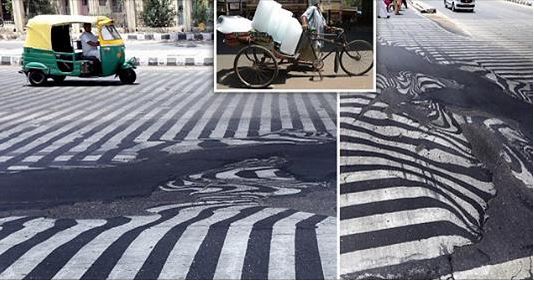
The death toll from India’s heatwave has risen to 1,100 as people battle to contend with conditions so hot that roads are beginning to melt.
Road surfaces in New Delhi have started melting as temperatures reached a scorching 45 degrees Celsius (113 degrees Fahrenheit). Forecasters have warned it will get even hotter. People are being told to stay indoors as the crisis continues.

BYPASS THE CENSORS
Sign up to get unfiltered news delivered straight to your inbox.
You can unsubscribe any time. By subscribing you agree to our Terms of Use
Latest Video
Though the intense heat is affecting everyone, the most vulnerable are homeless people and daily wage construction workers who work under the blistering sun
The Mail Online reports:
Southern India has been hit hardest by the sweltering weather and many of the victims are construction workers, elderly or homeless people unable to heed official advice to stay indoors.
In the worst-hit state of Andhra Pradesh nearly 900 people have died since May 18 – double the total number of heat-related deaths last summer, authorities said.
In neighbouring Telangana, where temperatures hit 48 degrees Celsius (118 degrees Fahrenheit) over the weekend, more than 200 people have died in the last week compared to 31 in the whole of last year.
In New Delhi, forecasters said they expected the high temperatures to continue into next week – adding to the misery of the thousands of poor living on the capital’s streets with little shelter from the hot sun.
Residents of Gurgaon – a high-rise satellite city that is home to many of the capital’s workers – suffered power cuts of up to 10 hours a day as the electricity grid struggled to cope with the demand from millions of air conditioners.
Nothing is working – even after taking half a dozen baths a day, you can’t beat the heat,’ 34-year-old shop owner Manish Singh told AFP in Gurgaon.
‘We try to spend more time indoors to avoid heatstroke. It’s worse than previous years — we hardly get any electricity and the air conditioners become useless.’
Weather officials said northwesterly dry and hot winds from the desert state of Rajasthan were responsible for the killer heatwave.
India’s power industry has long struggled to meet rapidly rising demand in Asia’s third-largest economy, which is plagued by poorly maintained transmission lines and overloaded grids.
The streets of Gurgaon were largely deserted on Wednesday, while the few people brave enough to venture outdoors covered their heads to protect them from the strong sun.
Sugarcane juice stalls were doing a brisk trade as construction workers and rickshaw pullers desperately tried to quench their thirst. Elsewhere volunteers were giving out cold drinks to motorists stuck in traffic.
Brahma Prakash Yadav, director of the Indian Meteorological Department, said top temperatures in the capital would remain around 45 degrees Celsius – the national benchmark for a heatwave.
‘Maximum temperatures won’t fall substantially. However, major relief can be expected from June 2 as there are indications of good showers,’ he said.
Hospitals in the worst-affected states were on alert to treat victims of heatstroke and authorities advised people to stay indoors and drink plenty of water.


